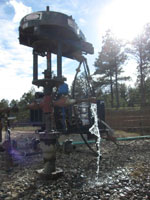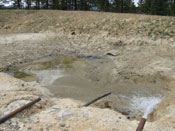About Produced Water (Produced Water 101)
Produced water is a byproduct of oil and gas exploration and production, it is generated in large volumes, and it plays a significant factor in the profitability of oil and gas production wells.
What is Produced Water?
Produced water is water trapped in underground formations that is brought to the surface during oil and gas exploration and production. In traditional oil and gas wells, produced water is brought to the surface along with oil or gas. In coal bed methane production, wells are drilled into coal seams, and the water located there is pumped to the surface in order to allow gas to release from the coal seams. Because the water has been in contact with the hydrocarbon-bearing formation for centuries, it has some of the chemical characteristics of the formation and the hydrocarbon itself. It may include water from the reservoir, water injected into the formation, and any chemicals added during the drilling, production, and treatment processes. Produced water can also be called "brine", "saltwater", or "formation water."
The physical and chemical properties of produced water vary considerably depending on the geographic location of the field, the geological formation from which it comes, and the type of hydrocarbon product being produced. Produced water properties and volume can even vary throughout the lifetime of a reservoir.
The major constituents of interest in produced water are:
- Salt content: Salt content can be expressed as salinity, total dissolved solids, or electrical conductivity. The salt content in produced water varies widely, from nearly freshwater to salt levels up to ten times higher than seawater.
- Oil and grease: Oil and grease is not an individual chemical. Rather, the term "oil and grease" refers to a common test method that measures many types of organic chemicals that collectively lend an "oily" property to the water.
- Various inorganic and organic chemicals: These chemicals are found naturally in the formation, are transferred to the water through long-term contact with the hydrocarbon, or are chemical additives used during drilling and operation of the well. The presence of specific chemicals and the concentrations of those chemicals vary widely among different produced water samples.
- Naturally occurring radioactive material (NORM): Some of the formations holding oil and gas have small concentrations of natural radioactivity. Low levels of the radioactivity can be transferred into produced water. Generally, the radiation levels in produced water are very low and pose no risk. However, scale from pipes and sludge from tanks holding produced water can concentrate NORM.
This website focuses on beneficial use of produced water. Most produced waters need some form of treatment before it can be used. The levels of specific constituents found in a particular produced water sample and the desired type of reuse will determine the types of treatment that are necessary.
How Much Produced Water is Generated?
Produced water is by far the largest volume byproduct stream associated with oil and gas exploration and production. Approximately 21 billion bbl (barrels; 1 bbl = 42 U.S. gallons) of produced water are generated each year in the United States from about 900,000 wells. This is equivalent to a volume of 2.4 billion gallons per day. Within the five Rocky Mountain States that are the focus of this website (Colorado, Montana, New Mexico, Utah, and Wyoming), approximately 430 million gallons of produced water are generated each day. Argonne National Laboratory has recently published a report titled Produced Water Volumes and Management Practices in the United States [PDF].
To put this volume into perspective, the large Denver Water agency, which supplies drinking water to the City and County of Denver and other customers who live in the surrounding suburbs (1.3 million customers), operates three traditional water treatment plants and one recycled water treatment plant. The combined total capacity of those plants is approximately 745 million gallons per day.
Why is Produced Water Important to the Oil and Gas Industry?
The cost of managing produced water is a significant factor in the profitability of oil and gas production. The total cost (ranging from less that 1 cent/bbl to more than $5/bbl) includes:
- The cost of constructing treatment and disposal facilities, including equipment acquisitions;
- The cost of operating those facilities, including chemical additives and utilities;
- The cost of managing any residuals or byproducts resulting from the treatment of produced water;
- Permitting, monitoring, and reporting costs; and
- Transportation costs.
Once the cost of managing produced water exceeds the value of the hydrocarbon produced from the well, the well is usually shut down.



